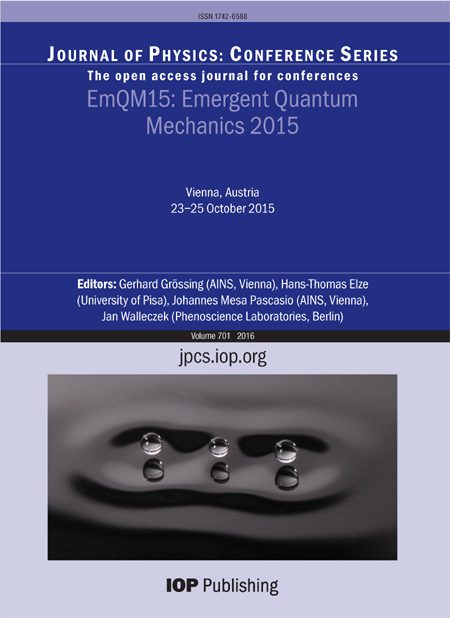The Third International Symposium on Emergent Quantum Mechanics.
The symposium invites the open exploration of the quantum state as a reality. The resurgence of interest in ontological quantum theory, including both deterministic and indeterministic approaches, challenges long held assumptions and directs focus towards the following questions: Is the world local or nonlocal? What is the nature of quantum nonlocality? If nonlocal, i.e., superluminal, influences exist then why can’t they be used for superluminal signalling and communication? How is the role of the scientific observer/agent to be accounted for in realistic approaches to quantum theory? How could recent developments in the field of space-time as an emergent phenomenon advance new insight at this research frontier? What new experiments might contribute to new understanding? These and related questions will be addressed in the context also of a possible „deeper level theory“ for quantum mechanics that interconnects three fields of knowledge: emergence, the quantum, and information. Could there appear a revised image of physical reality from recognizing new links between emergence, the quantum, and information? The symposium provides a forum for considering (i) current theoretical and conceptual obstacles which need to be overcome as well as (ii) promising developments and research opportunities on the way towards realistic quantum mechanics. Contributions are invited that present current advances in both standard as well as unconventional approaches.
Conference Prceedings
Journal of Physics: Conference Series Volume 701 (2016).

AINS contributions
Conditions for Lorentz-invariant superluminal information transfer without signaling
We understand emergent quantum mechanics in the sense that quantum mechanics describes processes of physical emergence relating an assumed sub-quantum physics to macroscopic boundary conditions. The latter can be shown to entail top-down causation, in addition to usual bottom-up scenarios. With this example it is demonstrated that definitions of „realism“ in the literature are simply too restrictive. A prevailing manner to define realism in quantum mechanics is in terms of pre-determination independent of the measurement. With our counter-example, which actually is ubiquitous in emergent, or self-organizing, systems, we argue for realism without pre-determination. We refer to earlier results of our group showing how the guiding equation of the de Broglie-Bohm interpretation can be derived from a theory with classical ingredients only. Essentially, this corresponds to a „quantum mechanics without wave functions“ in ordinary 3-space, albeit with nonlocal correlations.
This, then, leads to the central question of how to deal with the nonlocality problem in a relativistic setting. We here show that a basic argument discussing the allegedly paradox time ordering of events in EPR-type two-particle experiments falls short of taking into account the contextuality of the experimental setup. Consequently, we then discuss under which circumstances (i.e. physical premises) superluminal information transfer (but not signaling) may be compatible with a Lorentz-invariant theory. Finally, we argue that the impossibility of superluminal signaling – despite the presence of superluminal information transfer – is not the result of some sort of conspiracy (á la „Nature likes to hide“), but the consequence of the impossibility to exactly reproduce in repeated experimental runs a state’s preparation, or of the no-cloning theorem, respectively.
G Grössing, S Fussy, J Mesa Pascasio and H Schwabl
Conditions for Lorentz-invariant superluminal information transfer without signaling
G Grössing et al 2016 J. Phys.: Conf. Ser. 701 012006
Emergent quantum mechanics without wavefunctions
We present our model of an Emergent Quantum Mechanics which can be characterized by „realism without pre-determination“. This is illustrated by our analytic description and corresponding computer simulations of Bohmian-like „surreal“ trajectories, which are obtained classically, i.e. without the use of any quantum mechanical tool such as wavefunctions. However, these trajectories do not necessarily represent ontological paths of particles but rather mappings of the probability density flux in a hydrodynamical sense. Modelling emergent quantum mechanics in a high-low intesity double slit scenario gives rise to the „quantum sweeper effect“ with a characteristic intensity pattern. This phenomenon should be experimentally testable via weak measurement techniques.
J Mesa Pascasio, S Fussy, H Schwabl and G Grössing
Emergent quantum mechanics without wavefunctions
J Mesa Pascasio et al 2016 J. Phys.: Conf. Ser. 701 012036